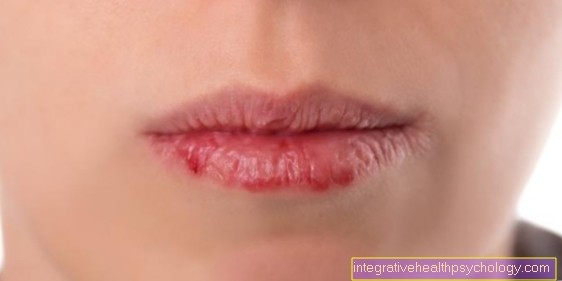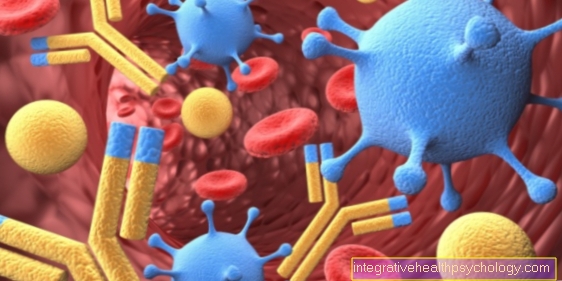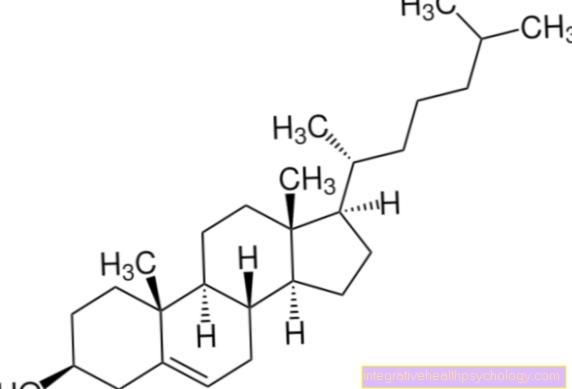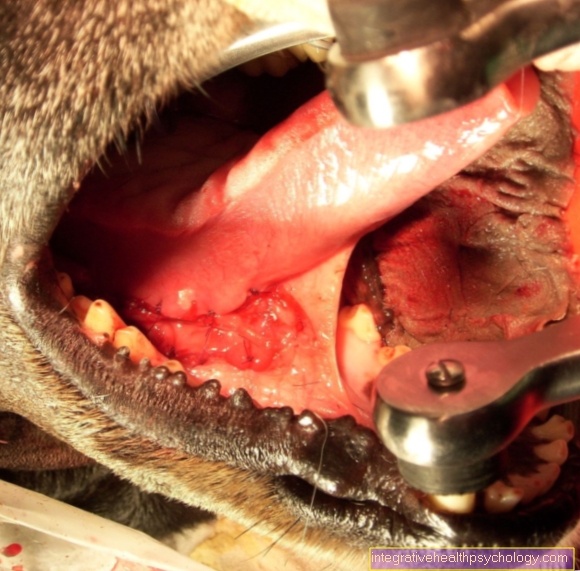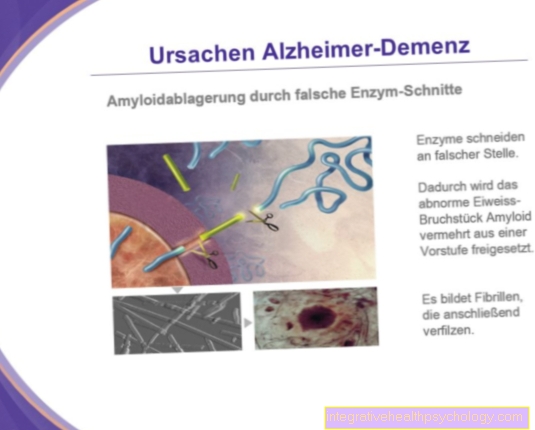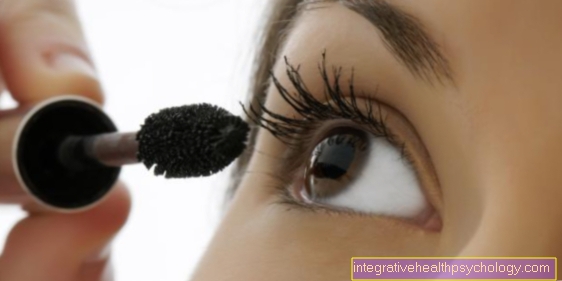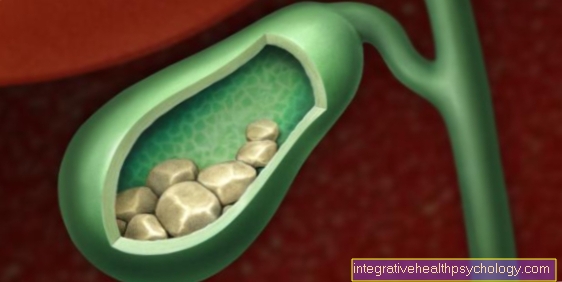Jaundice of the newborn
synonym
Neonatal jaundice, neonatal hyperbilirubinemia
engl.: jaundice
Definition and origin of the word
Newborn jaundice is the increased concentration of bilirubin, a breakdown product of the blood pigment hemoglobin, in the blood of the newborn. Jaundice occurs in more than half of all healthy newborns, whereby a bilirubin concentration of up to 15 mg / dl in the serum is regarded as physiological and harmless is. If the bilirubin concentration of 20 mg / dl in the serum is exceeded, one speaks of severe jaundice.
The term jaundice is derived from the yellow color of bilirubin, which, when the concentration in the blood is very high, affects the skin and dermis of the eye (Sclera) can turn yellow.
Jaundice prolongatus is a special form of neonatal jaundice: This jaundice lasts longer than two weeks and requires close medical monitoring of the child concerned.

Causes and development of neonatal icterus
In the womb, the fetus is supplied with oxygen via the diffusion of oxygen between the mother's and child's blood vessels. Since the oxygen content of the child's blood remains relatively low, the child develops a compensatory increased proportion of the red blood pigment hemoglobin in order to optimize oxygen transport.
After the birth, the child has sufficient oxygen and at the same time the fetal hemoglobin is exchanged for adult hemoglobin. This results in an increased breakdown of hemoglobin in the first few days of life, which the still immature liver cannot cope with adequately. An increased concentration of the hemoglobin breakdown product Bilirubin in the child's blood is the result.
Certain factors, most of which are associated with an increased breakdown of red blood cells, increase the risk of the child developing neonatal jaundice. Premature babies and sick children are particularly at risk.
Other risk factors in the newborn:
- decreased level of the "bilirubin transporter" albumin in the blood
- Hypoglycaemia or blood poisoning
- Lack of oxygen or shock
- Blood group incompatibility between mother and child
- Hemolytic diseases
- Large area hematomas (Bruising)
- Early onset of jaundice within 24 hours of birth
- Jaundice in a sibling
The presence of a bile duct obstruction (Biliary atresia) can prevent the excretion of bilirubin and should therefore be clarified. If the passage of the first bowel movement (meconium) is delayed, split bilirubin can increasingly be reabsorbed from the intestine and intensify the jaundice.
Liver values
In neonatal jaundice, indirect bilirubin is increased because the liver cannot convert it into direct bilirubin quickly enough. The indirect bilirubin is increased compared to the adult, the direct corresponds to the values of adults. Due to the increased indirect bilirubin, the total bilirubin is also increased. Accordingly, the total bilirubin concentration is checked in laboratory tests.
The limit on the first day of life is 8.7mg / dl, everything below that is normal. The normal values in children aged 4-6 days are between 0.1-12.6 mg / dl. If the value increases, the typical symptoms occur. Icterus gravis, i.e. severe jaundice, is the term used for values above 20 mg / dl in the mature newborn. If the newborn is still immature, severe jaundice can be present from values of 10 mg / dl. Early jaundice (icterus praecox) is when the newborn develops jaundice on the first day of life. The bilirubin rises to values above 12 mg / dl in the first 36 hours after birth.
Symptoms of neonatal icterus
The increased Bilirubin content of the blood turns the skin and the whites of the eyes yellow. At particularly high concentrations, the fat-soluble bilirubin can penetrate nerve cells and destroy them. This is how it initially occurs in the newborn inertia and fatigue as well as massive muscle weakness and a reduced need to drink. In the further course, frightfulness and violent backward bending of the head with simultaneous hyperextension of the entire body occur (opisthotonus). In the end stage, seizures and comatose states can occur up to the onset of death.
In so-called kernicterus, special parts of the brain are damaged, which can lead to unusual movements of the hands and feet (choreoathetosis) and numbness. As a rule, developmental disorders and intelligence deficits can also be expected.
In the majority of cases, however, the prognosis is very good and no permanent damage is to be expected.
Forms of neonatal icterus
In paediatrics (Pediatrics) different forms of neonatal icterus are distinguished:
Physiological neonatal icterus:
At the 3rd-6th Day of life the so-called physiological neonatal icterus occurs in the newborn child. This forms up to the 10th day of life back again.
The development of physiological neonatal jaundice is based on the combination of increased hemoglobin breakdown and immature liver function, which leads to an accumulation of unconjugated, water-insoluble bilirubin.
This so-called indirect bilirubin cannot be converted directly into direct and thus water-soluble bilirubin by the liver's UDP-gluoronyltransferase. That is why it is temporarily deposited and can be recognized, for example, by the yellow skin color. The condition is called hyperbilirubinemia.
If the newborn is breastfed, constituents of the breast milk can inhibit glucuronyl transferase, which is called breast milk terus.
Jaundice praecox:
Icterus praecox denotes in contrast to "normal"Neonatal icterus (see above) yellowing of the skin (Jaundice), which already exists on the first day of life.
The bilirubin is already rising in the first 36 hours of life on values over 12mg / dl on.
This metabolic disorder is usually caused by an AB0 blood group incompatibility between the newborn and mother.
Icterus gravis:
In this form of jaundice, the concentration of bilirubin in the mature newborn is higher than that 20 mg / dl.
If the diagnosis is to be made in an immature newborn, the limit should be set lower. Depending on age (in pregnancy weeks) and weight at birth already exist here from a bilirubin concentration of 10 mg / dl an icterus gravis.
Icterus prolongatus:
Icterus prolongatus is a neonatal icterus that has existed for more than two weeks.
Our next topic could also be of interest to you: Kernicterus in the baby
What is jaundice prolongatus?
An icterus prolongatus is understood as the persistent occurrence of increased bilirubin levels beyond the first week of life, according to other classifications only after the tenth or even fourteenth day of life of the newborn. This means that degradation products of the blood pigment hemoglobin are increasingly measurable, but do not exceed the value of 15 mg / dl.
Due to the increased level of the breakdown product in the infant's blood, the skin becomes yellow in color, known as jaundice. About 3-15% of all newborns suffer from the prolonged form of bilirubin surge. Like jaundice praecox (increased bilirubin levels within the first day of life) and jaundice gravis (values above 15 mg / dl), jaundice prolongatus is one of the pathological forms of newborn jaundice and requires regular medical checks.
In most cases, the elongated form of jaundice is due to an unconjugated hyperbilirubinemia. This means that due to the not yet fully developed liver function of the newborn, the conversion of the unconjugated, water-insoluble degradation substance bilirubin into its water-soluble form does not take place to a sufficient extent.
This state is often maintained by the components of breast milk, as these can block the enzymes that are important for the solubility process of bilirubin. In this case, one also speaks of breast milk terus, which, however, is usually temporary and subsides without consequences.
Other reasons for prolonged high bilirubin levels can include hypothyroidism, biliary obstruction, changes in the bile ducts and liver disease in the newborn. In addition, there are numerous other, sometimes very serious reasons for jaundice prolongatus, which require comprehensive diagnostic clarification and specific therapy.
You can read more about this here: Jaundice prolongatus
Therapy of neonatal icterus
If jaundice of a certain intensity has been detected by taking a blood sample, treatments are used to avoid long-term neurological effects in particular.
In general, there are two therapy methods to choose from: phototherapy and blood exchange transfusion.
Phototherapy alone is sufficient up to a certain limit value for the bilirubin concentration. The baby is irradiated with blue light with a wavelength of 460 nm. The Bilirubin is structurally modified in such a way that it can be excreted via the kidneys and bile without having to be broken down in the liver. The child should be as naked as possible so that a large area is irradiated. The child's eyes must be covered to avoid damaging the retina of the eye. The lamp is positioned at a distance of about 20 cm from the child. Repeated irradiations lasting 5 hours are usually sufficient, but in more severe cases the irradiation should be continuous.
If the bilirubin limit for irradiation is exceeded or if the bilirubin concentration does not drop, blood exchange transfusion is used. The child's blood is negatively exchanged for adult blood of blood group 0 rh via the umbilical vein. This stops the further breakdown of hemoglobin and thus the rise in the bilirubin level. Frequent feeding and hydration are recommended to help prevent the elimination of Bilirubin to stimulate. Further diagnostics can be carried out photometrically by transcutaneous multispectral measurement in order to check the bilirubin concentration in the skin.
For more information on treating jaundice, see: Therapy of jaundice
Effectiveness of phototherapy
The aim of phototherapy is to convert indirect bilirubin into direct by irradiating the skin. This is water-soluble and can then be excreted in the bile and urine.
Irradiation takes place with blue light with a wavelength of 420-480 nm. Mature newborns with a bilirubin value of over 20 mg / dl are treated. In premature babies the limit is 10 mg / dl. The phototherapy is carried out until the bilirubin has fallen to the normal values.
When it comes to radiation, it is important that the newborn receives sufficient fluid and that it wears eye protection. Side effects of therapy include diarrhea, dehydration, and separation from the mother. It also increases the risk of developing acute myeloid leukemia (AML).The therapy must not be carried out if there is an increase in direct bilirubin, as otherwise irreversible changes in skin color may occur (bronze baby syndrome).
You can read more detailed information on this topic here: Phototherapy
Homeopathy for neonatal icterus
There are few homeopathic remedies that can be used for neonatal icterus and that are useful. Before using these substances as the sole form of treatment, however, you should definitely consult a doctor.
In addition to the physiological, harmless neonatal jaundice, other forms of disease can also be considered that require further diagnostics and specific, medically supervised therapy in order to avoid complications and permanent damage.
Liver tea, for example, which the breastfeeding mother can drink and which can also be given to the infant in small quantities, is used in homeopathic terms. Grapefruit or artichoke juice can also be drunk by the mother. In addition, a liver-friendly diet with a reduction in the proportion of meat is recommended. Baby massages or liver wraps for newborns should also have a supportive effect.
When will my baby be healthy again?
The physiological, i.e. normal, neonatal jaundice usually occurs between the 3rd and 6th day of life and regresses by the 10th day after birth. So this jaundice can last up to a week. One speaks of a prolonged jaundice (Icterus prolongatus) if after the 10th day of life still elevated bilirubin values can be detected. There is a risk of brain damage here.

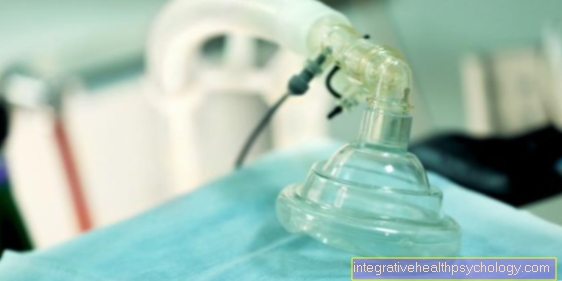


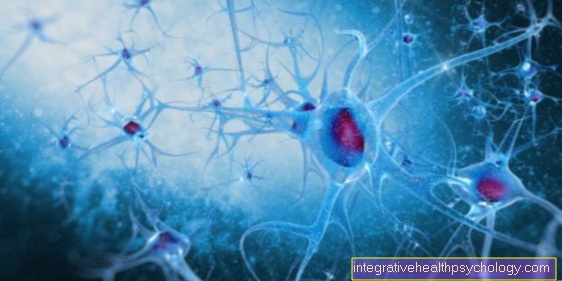
.jpg)

